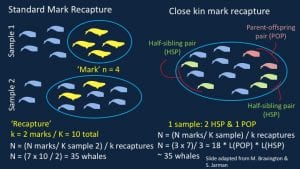Tohorā Voyages
For more see: www.tohoravoyages.ac.nz
Outreach
Challenge of monitoring long lived species
Monitoring biodiversity typically means monitoring populations. This means following individuals animals through their lives to understand factors such as how they use their environment, how long they live, and how many offspring they have. For long-lived species like whales and elephants, this means decades-long datasets are required to understand how well populations are doing. Even decades long datasets may not give a precise answer about basic questions, such as whether a population is increasing or decreasing. Given the world is changing rapidly, we need better and faster ways of assessing populations.
Genomic monitoring - identity and age of whales
Using a small skin sample from a free-ranging whale, we can identify individuals and their kin. A new method means that the age of a whale can also be estimated from their DNA. The age structure of a population tells you if it is growing (lots of young whales) or will shrink in future (lots of old whales). When this is combined with the kin relationships within the population, it can be an effective way to investigate key population parameters such as abundance and survival.
Family matters: collaboration to integrate genomic monitoring and close kin mark recapture
Emma Carroll was awarded a Royal Society Rutherford Discovery Fellowship to develop advanced genomic monitoring tools and close kin mark recapture methods for long-lived species, using New Zealand right whales as the novel model system.
This work is in collaboration with:
Dr Mark Bravington, CSIRO, pioneer of the close kin mark recapture method
Associate Professor Rochelle Constantine, University of Auckland, marine mammal expert
Associate Professor Rachel Fewster, University of Auckland, expert in mark recapture methods
Associate Professor Simon Jarman, Curtin University, developer of the method to estimate whale age using their DNA
Close kin mark recapture
Standard mark recapture tracks individuals across time. Individuals are marked, using bands, or identified using natural markings, in one survey. In the next survey, a proportion of these individuals will be recaptured. In combination with advanced statistical models, this information can provide estimates of abundance, survival and other demographic parameters.
Close kin mark recapture uses the patterns of recapture of kin to estimate these demographic parameters. It is based on the simple idea that every individual has two parents. The rate at which you recapture the parents tells you something about the size of the adult population. Capturing half-sibling pairs, those that have one parent in common, also provides information.
New Zealand right whales are an ideal model system because we have a unique genomic archive for the population, as they have been studied by the University of Auckland and Department of Conservation since 1995. This means we are able to develop genomic profiles to identify kin and develop a genetic assay to estimate age. This method will provide a faster way to asses the recovery of right whales in an era of climate change.
